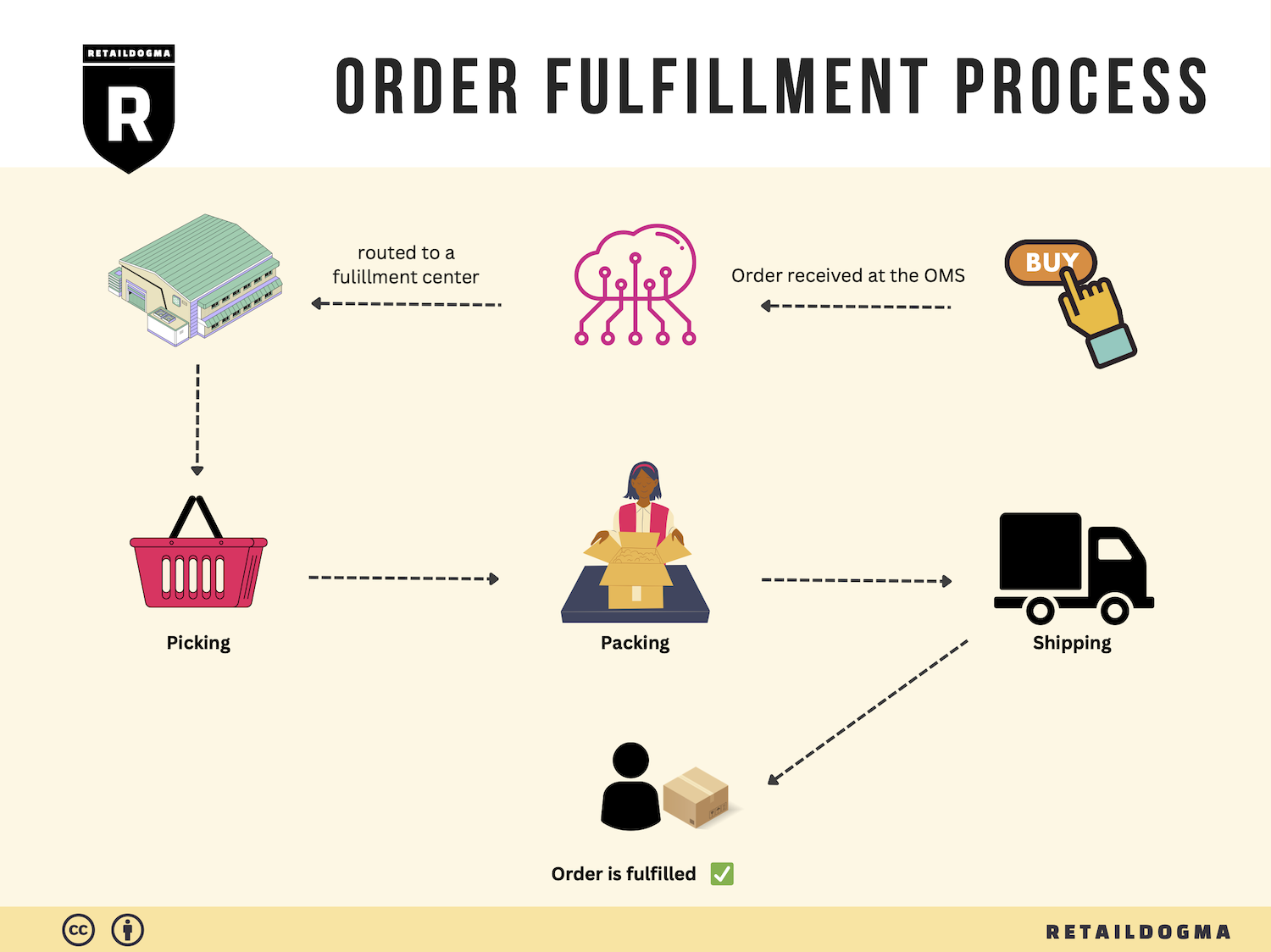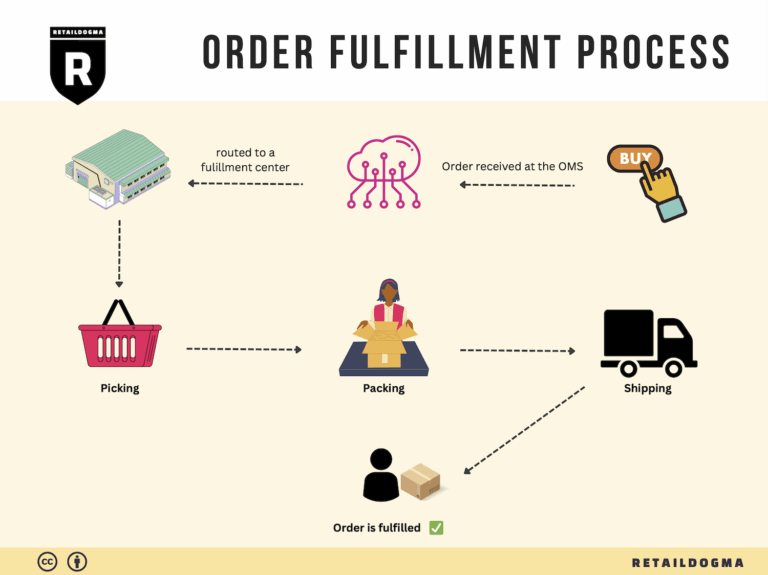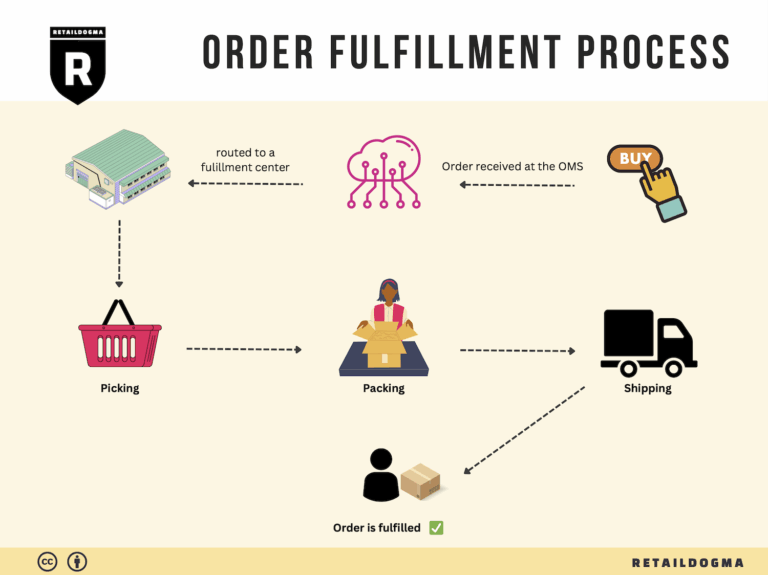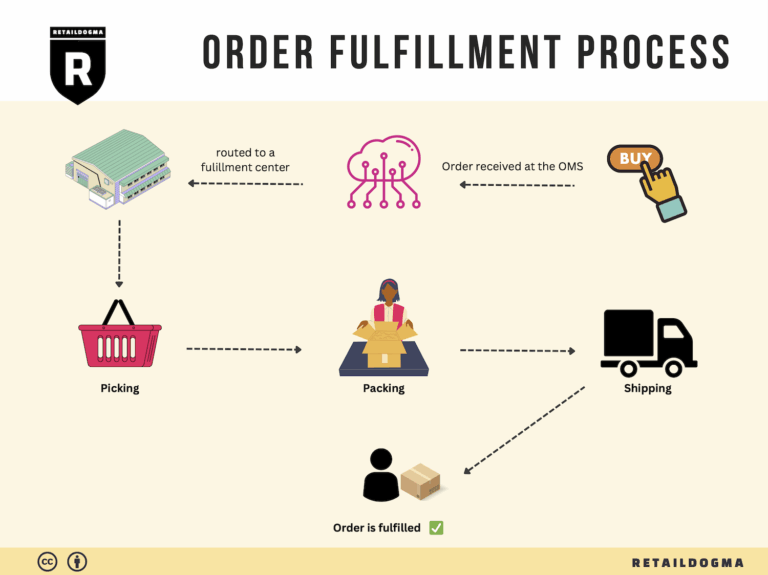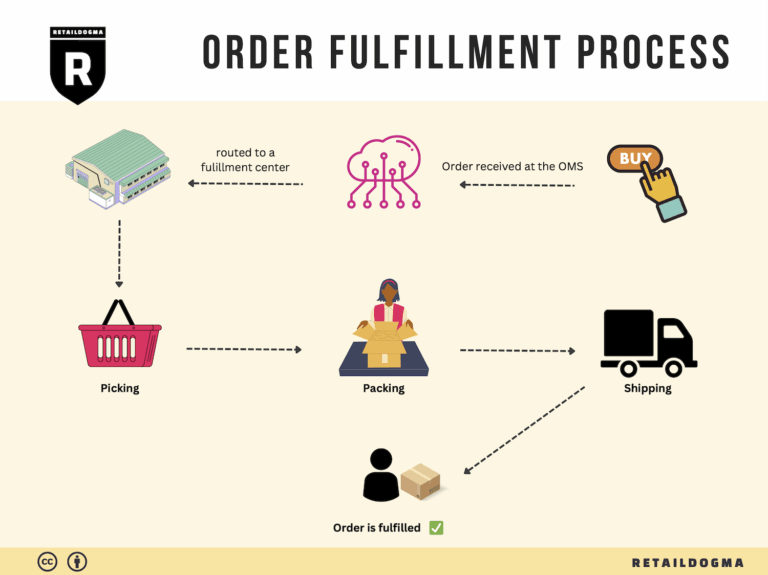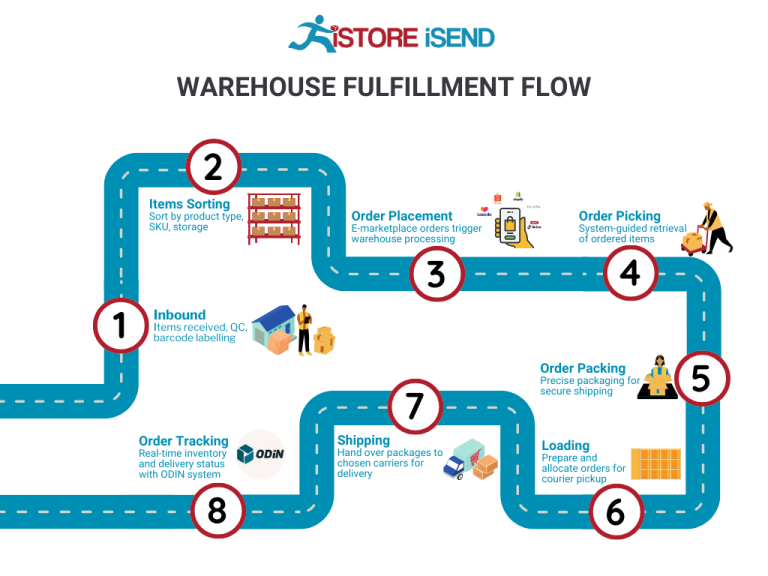Ecommerce Fulfillment Services: The Ultimate Guide (2025)
What is E-commerce Fulfillment? An Introduction for Growing Businesses
Navigating the Complexities of E-commerce Fulfillment
For many growing e-commerce businesses, the thrill of expanding sales often comes with the daunting challenge of packing and shipping orders. As your customer base grows, so does the volume of orders, leading to potential overwhelm in managing logistics. This is where understanding e-commerce fulfillment becomes essential. Fulfillment is simply the process of getting a product from your inventory to your customer’s doorstep. It encompasses everything from order processing and inventory management to packing and shipping.
In this guide, we will delve into the various fulfillment models available to e-commerce businesses, including Third-Party Logistics (3PL) and Fulfillment by Amazon (FBA). Each model offers distinct advantages and can significantly influence your operational efficiency and customer satisfaction. By understanding these options, you can choose the best fit for your business’s unique needs.
Moreover, we will explore the core services involved in fulfillment. These include warehousing, order processing, inventory management, packing, shipping, and returns handling. A clear grasp of these services will help you identify which aspects you may want to outsource to a fulfillment partner and which you may prefer to manage in-house.
Choosing the right fulfillment partner is another critical decision that can make or break your logistics strategy. We will outline key criteria to consider, such as reliability, technology integration, scalability, and customer service. The right partner not only streamlines your operations but also enhances the overall customer experience, ensuring timely delivery and accurate order fulfillment.
Pricing is an inevitable aspect of any logistics strategy, and it varies widely based on the fulfillment model, services offered, and the volume of orders processed. We will provide insights into the various pricing structures, helping you budget effectively while optimizing your fulfillment processes.
The ultimate goal of this guide is to empower e-commerce businesses like yours to make informed decisions about logistics. By understanding the intricacies of e-commerce fulfillment, you can alleviate the stress of packing and shipping, allowing you to focus on scaling your sales and enhancing your brand. With the right knowledge and resources, you can transform fulfillment from a pain point into a competitive advantage.
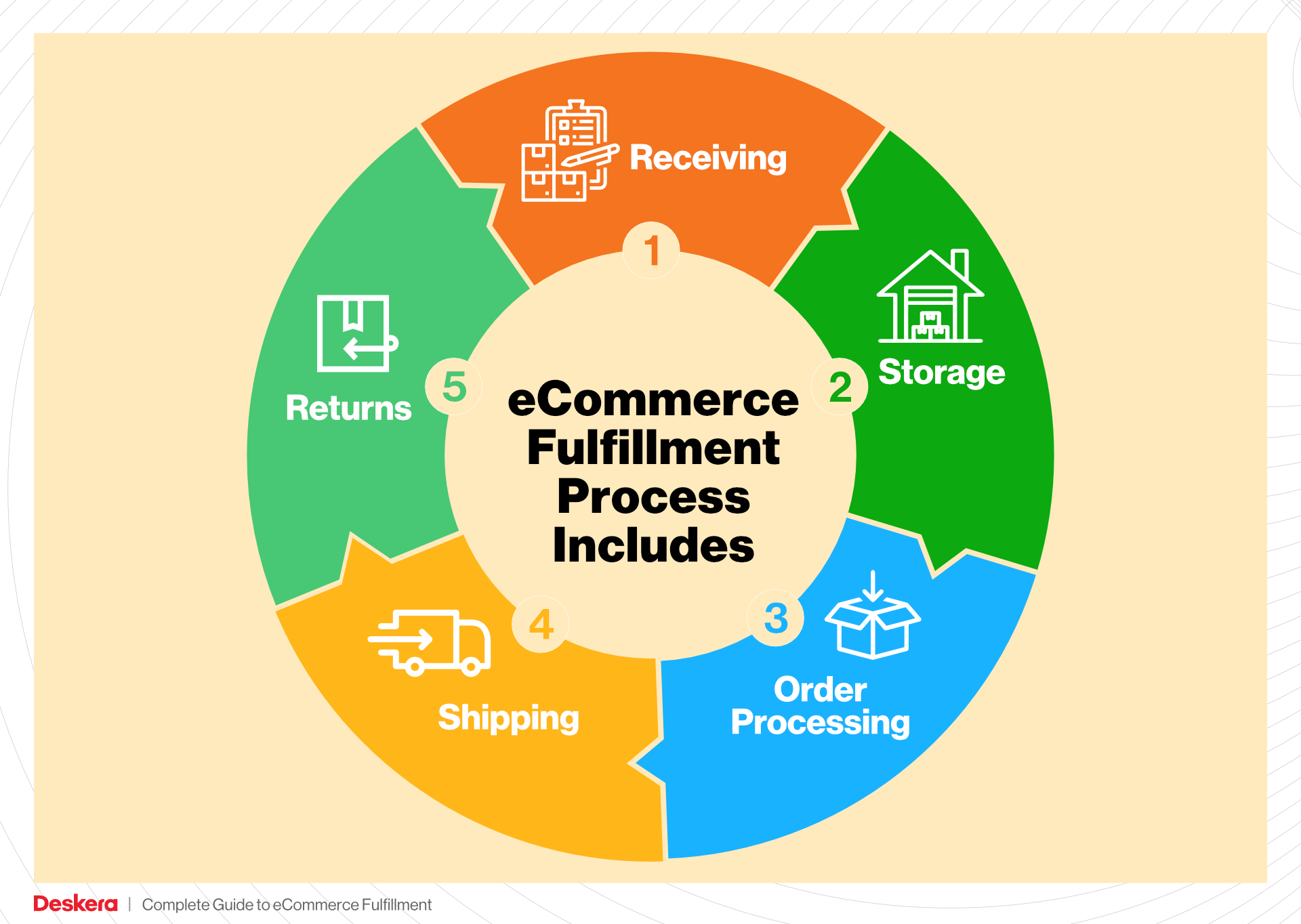
What You’ll Learn In This Guide
- What is E-commerce Fulfillment? An Introduction for Growing Businesses
- The Order Fulfillment Process: From ‘Buy’ Button to Customer’s Door
- Comparing Fulfillment Models: In-House vs. 3PL vs. Dropshipping
- A Deep Dive into Amazon FBA: Pros, Cons, and Who It’s For
- Core Services Offered by Fulfillment Centers
- How to Choose a Fulfillment Partner: A 6-Point Checklist
- Understanding Fulfillment Pricing: A Breakdown of Common Fees
- Frequently Asked Questions (FAQs) about Fulfillment
- Conclusion: Is Outsourcing Fulfillment the Right Move for Your Business?
- Important Disclaimer
The Order Fulfillment Process: From ‘Buy’ Button to Customer’s Door
1. Receiving Inventory
The first step in the order fulfillment process is receiving inventory. This is where suppliers deliver products to the fulfillment center. Upon arrival, each shipment is meticulously checked against purchase orders to ensure accuracy in quantity and quality. This process often involves scanning barcodes or QR codes to record the items into the inventory management system, which utilizes Stock Keeping Units (SKUs) for precise tracking.
Why is this important? Accurate receiving is crucial for maintaining inventory integrity and ensuring that the right products are available for customer orders. Discrepancies at this stage can lead to stockouts or excess inventory, both of which can hinder customer satisfaction and profitability. Efficient receiving processes help streamline the entire fulfillment pipeline, ensuring that products are readily available for the next steps.
2. Warehouse Storage
Once inventory is received and verified, it moves to warehouse storage. Fulfillment centers employ various storage methods, such as pallet racking and shelving, to optimize space and facilitate easy access to products. The key term here is “slotting,” which refers to the strategic placement of items based on their sales velocity and size.
The importance of effective warehouse storage cannot be overstated. Proper slotting reduces the time employees spend searching for products during the order picking phase, which directly impacts order fulfillment speed. Additionally, it minimizes the risk of damage to inventory, as items are stored in a manner that protects them from potential hazards. Efficient storage solutions also enable businesses to maximize their warehouse space, potentially lowering operational costs.
3. Order Picking
The next step is order picking, where employees or automated systems retrieve items from storage based on customer orders. A crucial tool in this process is the “pick list,” a document or digital display that outlines the items needed for each order, including their locations within the warehouse.
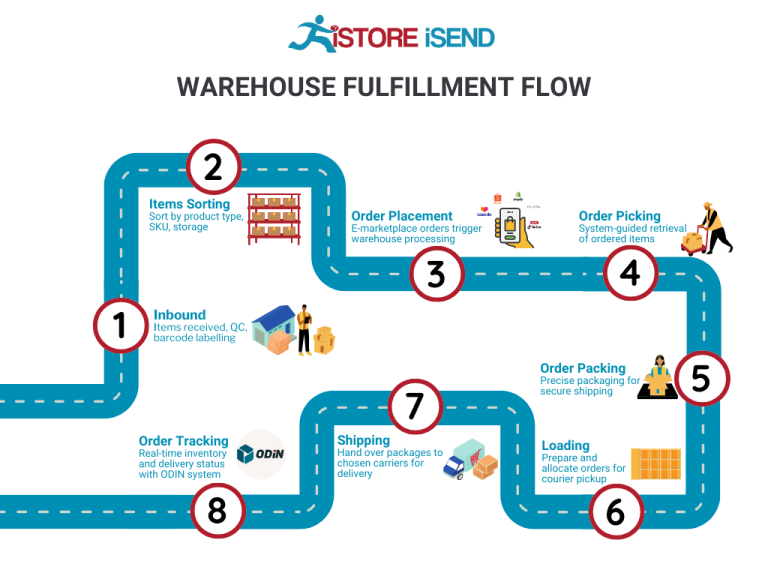
Order picking is vital because it directly affects the accuracy and speed of fulfillment. Delays or errors in this step can lead to incorrect shipments, which can damage customer trust and satisfaction. Many fulfillment centers employ various picking methods, such as single order picking, batch picking, or zone picking, depending on the volume of orders and the types of products handled. Implementing efficient picking strategies can significantly enhance productivity and accuracy, leading to improved customer experiences.
4. Order Packing
After items are picked, they proceed to the packing station. This step involves carefully packing the products into boxes or envelopes, ensuring they are secure for transit. Key considerations include choosing the right packaging materials and including necessary documentation, such as packing slips and return instructions. The term “packaging optimization” refers to the process of selecting the most efficient packing solutions to reduce shipping costs and environmental impact.
Packing is critical for maintaining product integrity during shipping. Well-packed orders minimize the risk of damage, which can lead to costly returns and customer dissatisfaction. Moreover, an efficient packing process can speed up the overall fulfillment timeline, allowing businesses to ship orders more quickly. Many fulfillment centers are now integrating technology, such as automated packing systems, to enhance this step’s efficiency and accuracy.
5. Shipping & Delivery
The final step in the order fulfillment process is shipping and delivery. Once orders are packed, they are labeled and prepared for dispatch. This involves selecting the best shipping carrier based on factors like cost, delivery speed, and reliability. The concept of “last-mile delivery” becomes particularly relevant here, as it refers to the final leg of the delivery journey from the shipping hub to the customer’s doorstep.
Shipping and delivery are crucial for customer satisfaction, as timely and accurate delivery can significantly enhance the overall shopping experience. Businesses must also track shipments to provide customers with real-time updates, which can help build trust and transparency. Efficient shipping processes not only improve customer satisfaction but can also lead to repeat business, as customers are more likely to return to businesses that consistently deliver on their promises.
In conclusion, understanding each step of the order fulfillment process is vital for e-commerce businesses looking to scale their operations effectively. By optimizing these steps—from receiving inventory to shipping and delivery—businesses can enhance their efficiency, reduce costs, and ultimately improve customer satisfaction, paving the way for growth in a competitive market.
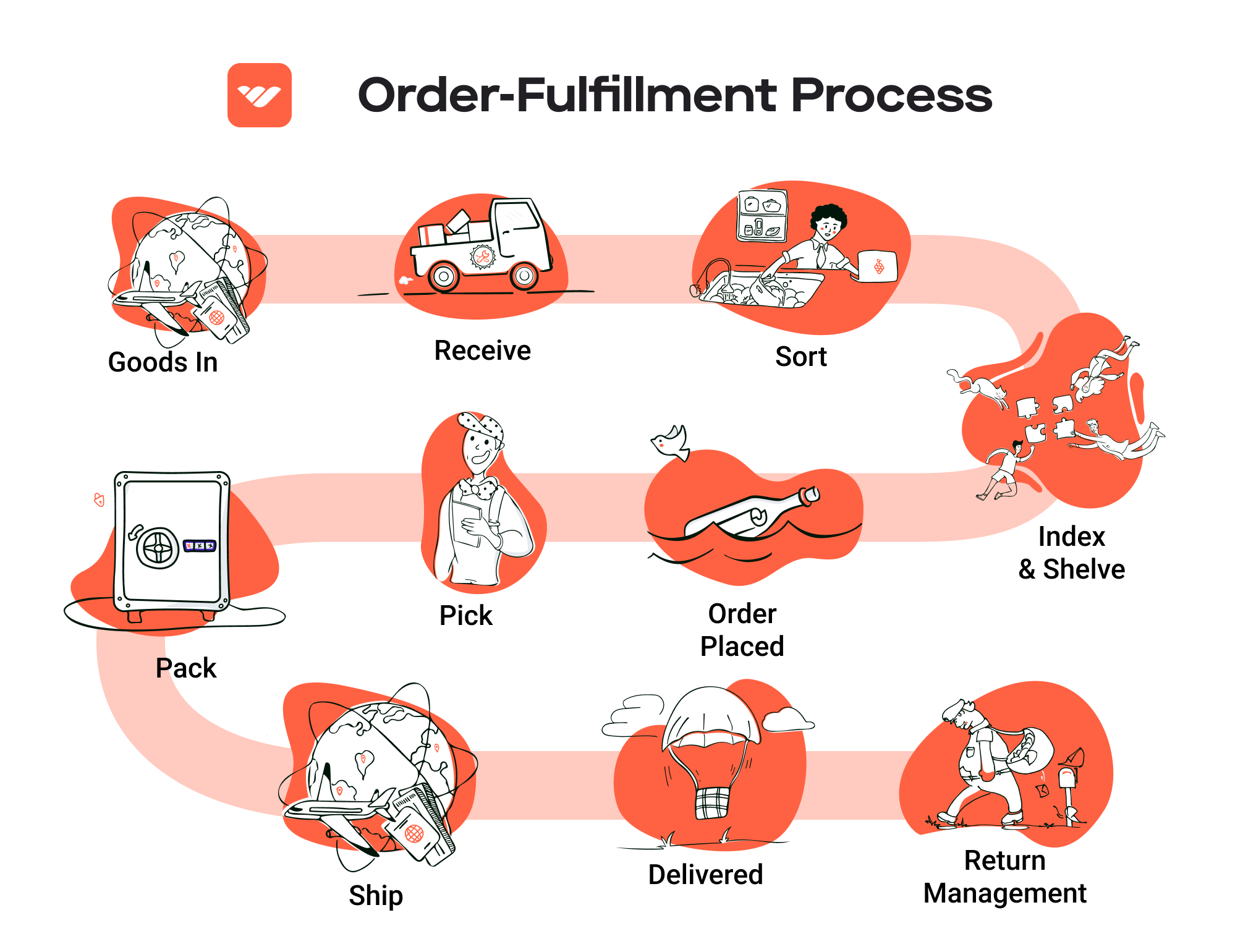
Comparing Fulfillment Models: In-House vs. 3PL vs. Dropshipping
Fulfillment Model Comparison
| Model | Who Handles Inventory | Best For (Business Stage) | Key Advantage | Key Disadvantage |
|---|---|---|---|---|
| In-House Fulfillment | The business itself | Established businesses | Full control over inventory and processes | High overhead costs and resource-intensive |
| Third-Party Logistics (3PL) | A third-party provider | Growing businesses | Scalability and expertise in logistics | Less control over inventory management |
| Dropshipping | Supplier or manufacturer | Startups or small businesses | Low startup costs and no inventory management | Lower profit margins and reliance on suppliers |
In-House Fulfillment
In-house fulfillment involves a company managing its inventory and logistics processes internally. This model is ideal for established businesses that have the resources to invest in warehousing, staffing, and technology. The key advantage of in-house fulfillment is the complete control it offers over inventory management, order processing, and customer service. Businesses can tailor their logistics processes to meet specific customer needs and optimize efficiency. However, this model requires significant capital investment and ongoing operational costs, including staffing, warehousing, and technology. Additionally, businesses must be prepared to handle fluctuations in demand, which can lead to excess inventory or stockouts, affecting overall profitability.
Third-Party Logistics (3PL)
Third-party logistics (3PL) providers offer a flexible and scalable solution for businesses looking to streamline their fulfillment operations. In this model, a business outsources its warehousing, inventory management, and shipping to a specialized logistics provider. This approach is particularly beneficial for growing businesses that want to scale operations without the burden of managing logistics themselves. A key advantage of 3PL is the access to industry expertise, advanced technology, and economies of scale, which can lead to reduced shipping costs and improved delivery times. However, partnering with a 3PL also means relinquishing some control over inventory management and order fulfillment processes. Businesses must carefully select a reliable provider to ensure that service levels meet customer expectations and maintain brand integrity.
Dropshipping
Dropshipping is a fulfillment model where the retailer does not hold inventory but instead relies on suppliers or manufacturers to ship products directly to customers. This model is particularly attractive for startups or small businesses with limited resources, as it requires minimal upfront investment and no need for warehousing. The primary advantage of dropshipping is the low barrier to entry, enabling entrepreneurs to launch online stores without the financial risk associated with purchasing inventory. However, dropshipping comes with its own set of challenges, including lower profit margins due to reliance on suppliers and potential issues with product quality and shipping times. Additionally, businesses have limited control over inventory levels and fulfillment processes, which can lead to customer dissatisfaction if not managed properly.
Conclusion
Choosing the right fulfillment model is crucial for scaling an e-commerce business effectively. Each model offers distinct advantages and disadvantages, and the decision should align with the company’s current stage, resources, and long-term goals. Established businesses may find in-house fulfillment aligns with their desire for control, while growing companies might benefit from the scalability of 3PL. Conversely, startups may prefer the low-risk approach of dropshipping to test markets without the burden of inventory. As businesses evolve, they may even consider transitioning between models to optimize their fulfillment strategies for growth and customer satisfaction.
A Deep Dive into Amazon FBA: Pros, Cons, and Who It’s For
Understanding Fulfillment by Amazon (FBA)
Fulfillment by Amazon (FBA) is a service that allows e-commerce sellers to leverage Amazon’s extensive logistics and fulfillment infrastructure. By using FBA, sellers can store their products in Amazon’s fulfillment centers, where Amazon takes care of storage, packaging, and shipping. This not only streamlines the order fulfillment process but also provides sellers with access to Amazon’s vast customer base and resources.
When a customer places an order for a product fulfilled by FBA, Amazon handles the entire process—from picking the item off the shelf, packing it in a box, and shipping it directly to the customer. Additionally, FBA products are eligible for Amazon Prime, which enhances visibility and appeal to a broader audience.
How FBA Works
-
Product Listing: Sellers create product listings on Amazon and specify which items they want to fulfill through FBA.
-
Shipping Inventory: Sellers send their products to Amazon’s fulfillment centers. Amazon provides guidance on how to prepare and package items to meet their requirements.
-
Storage: Once the products arrive at the fulfillment center, they are stored until an order is placed. Amazon’s sophisticated inventory management system tracks stock levels and replenishes when necessary.
-
Order Fulfillment: When an order is placed, Amazon’s systems automatically pick, pack, and ship the product. Customers receive notifications and tracking information, enhancing the overall experience.
-
Customer Service: Amazon also manages all customer service inquiries related to FBA orders, including handling returns and refunds.
Pros of Using FBA
1. Prime Eligibility
FBA products automatically qualify for Amazon Prime, making them more attractive to millions of Prime members who seek fast, free shipping. This can significantly increase sales as Prime members tend to prefer buying products that come with these benefits.
2. Customer Trust
Products fulfilled by Amazon benefit from the trust and reputation associated with the Amazon brand. Customers feel more secure purchasing items that are backed by Amazon’s customer service and return policies, which can lead to higher conversion rates.
3. Multi-Channel Fulfillment
FBA offers sellers the ability to fulfill orders from other sales channels, such as their own websites or other marketplaces, using Amazon’s logistics. This flexibility allows businesses to streamline their operations and maintain a consistent fulfillment process across platforms.
4. Scalability
FBA allows sellers to scale their operations without the need for significant investments in warehousing and logistics. As demand grows, sellers can easily send more inventory to Amazon without worrying about the complexities of managing fulfillment themselves.
5. Advanced Logistics and Technology
Amazon employs cutting-edge technology and logistics strategies that are difficult for smaller businesses to replicate. This includes automated systems, real-time inventory tracking, and sophisticated algorithms that optimize shipping and delivery.
Cons of Using FBA
1. High Fees
While FBA offers many benefits, it also comes with a range of fees, including storage fees for holding inventory and fulfillment fees for each order shipped. These costs can add up, particularly for low-margin products, impacting overall profitability.
2. Strict Inventory Rules
Amazon has stringent rules regarding inventory management, including requirements for product preparation, labeling, and storage. Non-compliance can lead to additional charges or even the removal of inventory from fulfillment centers.
3. Commingling Risks
FBA allows for commingling of inventory, which means that multiple sellers’ products may be stored together in the same location. This can lead to issues where a seller might ship a product that is defective or not as described, damaging their reputation and increasing the likelihood of returns.
4. Loss of Control
When using FBA, sellers relinquish some control over the fulfillment process. This includes packaging, branding, and customer interactions. For some businesses, particularly those focused on brand experience, this can be a significant drawback.
5. Inventory Management Challenges
Managing inventory levels can be complex, especially during peak seasons. Sellers must accurately forecast demand to avoid stockouts or excessive storage fees for unsold items.
Who is FBA Best For?
Fulfillment by Amazon is particularly well-suited for:
-
Small to Medium-Sized Businesses: Those looking to scale quickly without investing heavily in logistics can benefit from FBA’s infrastructure.
-
E-commerce Entrepreneurs: Individuals starting their businesses who want to tap into Amazon’s customer base and logistics without the overhead of managing their fulfillment centers.
-
Sellers with High Turnover Products: Businesses that sell fast-moving consumer goods will find FBA advantageous due to the speed of delivery and customer trust associated with Amazon.
-
Brands Seeking Prime Exposure: Companies that want to enhance their visibility and sales through Amazon Prime can leverage FBA to reach more customers.
-
Multi-Channel Sellers: Businesses that sell on multiple platforms can streamline their operations using FBA for order fulfillment, making it easier to manage logistics across channels.
In conclusion, while Fulfillment by Amazon offers a plethora of advantages for e-commerce sellers, it’s essential to weigh these against the potential drawbacks. Understanding your business model, product type, and target audience will help determine if FBA is the right fit for you.
Core Services Offered by Fulfillment Centers
Inventory Management & Warehousing
Inventory management and warehousing are foundational services provided by fulfillment centers. This involves the systematic storage and organization of products to ensure they are easily accessible for order fulfillment. Fulfillment centers utilize sophisticated inventory management systems that track stock levels in real-time, allowing businesses to maintain optimal inventory levels without the risk of overstocking or stockouts.
Benefits:
1. Efficiency: With advanced inventory management systems, e-commerce businesses can automate stock tracking, reducing the manual labor involved in inventory oversight. This efficiency leads to faster order processing and minimizes human error.
-
Cost-Effectiveness: By utilizing a fulfillment center’s warehousing services, businesses can avoid the overhead costs associated with maintaining their own storage facilities. This includes rent, utilities, and staffing costs, allowing businesses to allocate resources more effectively.
-
Scalability: As e-commerce businesses grow, their inventory needs can fluctuate significantly. Fulfillment centers provide the flexibility to scale storage space up or down based on demand, ensuring that businesses can adapt to market changes without significant financial investment.
-
Data Insights: Many fulfillment centers offer analytics tools that provide insights into inventory turnover rates, seasonal demand, and product performance. This data empowers businesses to make informed decisions regarding product lines and purchasing strategies.
Pick and Pack Services
Pick and pack services refer to the processes involved in selecting items from inventory and packaging them for shipment to customers. Fulfillment centers employ sophisticated technology and trained personnel to ensure accuracy and efficiency in this critical stage of order fulfillment.
Benefits:
1. Speed: Fulfillment centers are designed to optimize the pick and pack process, often using automated systems and robotics to speed up the selection and packaging of products. This rapid processing reduces delivery times, enhancing customer satisfaction.
-
Accuracy: With advanced scanning technologies and systematic processes, fulfillment centers significantly reduce the likelihood of errors in order fulfillment. Accurate order processing leads to higher customer trust and lower return rates.
-
Customization: Many fulfillment centers offer customized packing options, including branded packaging or gift wrapping. This personalization enhances the customer experience and can improve brand loyalty.
-
Labor Efficiency: By outsourcing pick and pack operations to a fulfillment center, businesses can focus their workforce on core activities such as marketing and customer service rather than logistics. This shift allows for more strategic growth initiatives.
Kitting and Assembly
Kitting and assembly services involve grouping multiple items together into a single package or assembling components into a final product. This service is particularly beneficial for e-commerce businesses that offer bundled products or require assembly before shipping.
Benefits:
1. Convenience: Kitting simplifies the ordering process for customers by providing them with bundled products that meet their needs. This convenience can lead to increased average order values and higher customer satisfaction.
-
Streamlined Operations: By allowing fulfillment centers to handle kitting and assembly, businesses can streamline their operations and reduce the complexity of their supply chain. This efficiency can lead to faster turnaround times and improved productivity.
-
Inventory Management: Kitting allows businesses to manage their inventory more effectively by reducing the number of individual SKUs. This simplification can lead to better inventory turnover and reduced holding costs.
-
Enhanced Marketing Opportunities: Bundled products can be marketed as special deals or seasonal promotions, driving additional sales. Fulfillment centers can assist in creating attractive packaging that enhances the perceived value of these bundles.
Returns Management (Reverse Logistics)
Returns management, or reverse logistics, refers to the processes involved in handling returned products. Effective returns management is crucial for e-commerce businesses, as it directly impacts customer satisfaction and retention.
Benefits:
1. Customer Satisfaction: A streamlined returns process enhances the overall shopping experience for customers. By providing easy return options, businesses can build trust and encourage repeat purchases.
-
Cost Reduction: Fulfillment centers often have established processes for handling returns, which can reduce the operational costs associated with processing returns in-house. This efficiency can translate into significant savings.
-
Data Analysis: Returns management systems can provide valuable insights into customer behavior, helping businesses identify trends in product returns. This information can guide product development and inventory decisions.
-
Restocking and Resale: Fulfillment centers can efficiently assess returned items for restocking or refurbishment. By minimizing the time products spend in the returns process, businesses can quickly return items to inventory, maximizing their resale potential.
In summary, partnering with a fulfillment center offers e-commerce businesses a comprehensive suite of services that enhance operational efficiency, reduce costs, and improve customer satisfaction. By leveraging these core services, businesses can scale their operations effectively while maintaining a focus on growth and customer engagement.
How to Choose a Fulfillment Partner: A 6-Point Checklist
Location & Warehouse Network
Importance:
The geographical location of your fulfillment partner’s warehouses can significantly affect shipping times and costs. A strategically located warehouse network can enhance your delivery speed, which is critical for customer satisfaction in today’s e-commerce environment.
Questions to Ask:
– Where are your fulfillment centers located, and how do those locations align with my target markets?
– What is your average shipping time to major metropolitan areas?
– Do you have a multi-warehouse strategy, and can you support regional distribution?
Technology & Integrations
Importance:
In the digital age, technology is the backbone of efficient fulfillment operations. A partner with robust technology can streamline processes, reduce errors, and provide real-time tracking for both you and your customers.
Questions to Ask:
– What software do you use for order management, inventory tracking, and reporting?
– Can your systems integrate seamlessly with my e-commerce platform (e.g., Shopify, WooCommerce, Amazon)?
– Do you offer API access for custom integrations, and how frequently do you update your technology?
Specializations (e.g., cold storage, oversized items)
Importance:
Depending on your product types, you may require a fulfillment partner with specific capabilities. For example, businesses selling perishable goods need cold storage, while those with large items might need specialized handling and shipping.
Questions to Ask:
– What types of products do you specialize in, and do you have the necessary facilities to handle them?
– Can you accommodate unique requirements, such as climate control or specialized packaging?
– Have you handled similar products to mine in the past, and can you provide case studies or references?
Scalability & Capacity
Importance:
As your business grows, your fulfillment needs will likely change. A capable partner should not only meet your current demands but also have the infrastructure to scale alongside your business.
Questions to Ask:
– What is your current capacity, and how do you handle peak seasons or unexpected spikes in demand?
– How do you manage inventory overflow during high-demand periods?
– Can you provide a roadmap for scaling operations as my sales grow?
Pricing and Contracts
Importance:
Understanding the pricing structure and contractual obligations is crucial for budgeting and financial planning. Hidden fees or unfavorable terms can erode your profit margins.
Questions to Ask:
– What is your pricing model (e.g., per order, per item, storage fees), and are there any additional costs I should be aware of?
– Can you provide a detailed quote that outlines all potential fees?
– What are the terms of your contract, and is there flexibility for renegotiation as my business evolves?
Customer Support & Reviews
Importance:
Effective customer support is vital for resolving issues quickly and maintaining operational efficiency. Additionally, researching reviews can provide insights into the partner’s reliability and service quality.
Questions to Ask:
– What customer support channels do you offer (e.g., phone, email, chat), and what are your response times?
– Can you provide references from current clients, particularly those in my industry?
– How do you handle fulfillment errors or customer complaints, and what is your process for continuous improvement?
Conclusion
Choosing the right fulfillment partner is a critical decision that can significantly impact your business’s efficiency and customer satisfaction. By following this checklist and asking the right questions, you can identify a partner that aligns with your operational needs and growth goals. Remember, the best fulfillment partner is one that not only meets your current requirements but also supports your long-term vision for scaling your e-commerce business.
Understanding Fulfillment Pricing: A Breakdown of Common Fees
Initial Setup Fees
When you decide to utilize a fulfillment service, the first cost you might encounter is the initial setup fee. This fee is typically a one-time charge that covers the costs associated with onboarding your business onto the fulfillment platform. This may include creating your account, integrating your e-commerce platform, and configuring your inventory management system.
The calculation of initial setup fees can vary widely based on the fulfillment provider. Some providers may charge a flat fee, while others may base it on the complexity of your business needs, such as the number of SKUs (stock-keeping units) you have or the level of customization required for your integration. It’s essential to clarify what this fee encompasses and whether there are any additional costs for ongoing support or updates.
Receiving Fees
Once your products arrive at the fulfillment center, receiving fees come into play. These fees are charged for the process of inspecting, unpacking, and storing your inventory. Receiving fees can be structured either as a flat rate per shipment or calculated based on the volume of goods received.
Typically, fulfillment centers charge a fee per pallet or per item received. If your products require special handling or quality checks, additional charges may apply. Understanding how these fees are structured is crucial, as unexpected costs can quickly add up if your shipments are large or frequent. Always inquire about any potential surcharges for expedited receiving or special handling requirements.
Storage Fees (per pallet/bin)
Storage fees are another critical component of fulfillment pricing. These fees are incurred for the space your inventory occupies within the fulfillment center. Fulfillment centers usually charge storage fees on a monthly basis, calculated either per pallet, per bin, or per cubic foot.
The rate for storage can vary based on the type of products you store. For instance, seasonal items may have different storage costs compared to fast-moving consumer goods. Additionally, if your inventory exceeds a certain threshold, you might incur overage fees. To optimize your storage costs, regularly review your inventory turnover rates and consider strategies to minimize excess stock.
Pick & Pack Fees (per item/order)
Pick and pack fees are charged for the labor involved in retrieving items from the warehouse and preparing them for shipment. This fee is generally calculated on a per-item or per-order basis. The more items included in an order, the higher the pick and pack fee.
Fulfillment centers may have different tiers of pick and pack fees based on the complexity of the order. For example, orders requiring special packaging or kitting may incur higher charges. To manage these costs effectively, it’s advisable to streamline your product offerings and packaging processes where possible, ensuring that orders can be picked and packed efficiently.
Shipping Fees
Shipping fees encompass the costs associated with transporting your products from the fulfillment center to your customers. These fees can vary significantly based on factors such as the shipping method (standard vs. expedited), destination, package weight, and dimensions.
Most fulfillment centers will provide a shipping fee calculator based on your specifications. However, it’s essential to understand the shipping agreements they have with carriers, as some fulfillment centers may offer discounted rates based on their shipping volume. Additionally, keep an eye on the potential for dimensional weight pricing, which can affect costs for larger but lighter packages.
Tips for Getting an Accurate Quote
-
Detailed Inventory Information: Provide a comprehensive list of your products, including dimensions, weights, and any special handling requirements. This information will enable fulfillment providers to give you a more accurate estimate.
-
Understand Fee Structures: Ask potential fulfillment partners to break down their pricing models, including any variable costs. Understanding how fees are calculated will help you anticipate potential expenses.
-
Compare Multiple Quotes: Don’t settle for the first quote you receive. Compare offers from different fulfillment centers to find the best value for your needs.
-
Inquire About Hidden Fees: Ask about any additional fees that may not be immediately apparent, such as surcharges for seasonal inventory, returns processing, or storage overage fees.
-
Consider Long-term Costs: Look beyond initial setup fees and consider the total cost of fulfillment over time, including storage and shipping. This will help you gauge the overall sustainability of the partnership.
By understanding these components and carefully evaluating potential partners, you can make informed decisions that support your business’s growth while effectively managing fulfillment costs.
Frequently Asked Questions (FAQs) about Fulfillment
1. What is an Amazon Fulfillment Center?
An Amazon Fulfillment Center is a large warehouse facility where Amazon stores a vast array of products. These centers utilize advanced technology and automation to efficiently process orders, manage inventory, and ship products directly to customers. They serve as a critical hub in Amazon’s supply chain, enabling rapid delivery to consumers.
2. How does a fulfillment center differ from a traditional warehouse?
While both fulfillment centers and traditional warehouses store products, their functions differ significantly. A fulfillment center is designed for order processing and shipping, focusing on quickly fulfilling customer orders. In contrast, a traditional warehouse primarily serves as a storage space without the same emphasis on order processing speed or customer service.
3. What can I expect during a visit to an Amazon Fulfillment Center?
During your visit, you can expect a guided tour showcasing the technology, processes, and people behind Amazon’s fulfillment operations. Tours typically last 45-60 minutes and include walking through various areas of the facility, observing robotic systems, conveyor belts, and employee interactions, all while learning about Amazon’s commitment to innovation and sustainability.
4. What is a 3PL (Third-Party Logistics) provider?
A 3PL is a service provider that manages logistics and supply chain functions for businesses, including warehousing, transportation, and order fulfillment. Companies often partner with 3PLs to streamline their operations, reduce costs, and focus on core business activities. Amazon also offers fulfillment services through its Fulfillment by Amazon (FBA) program, which acts as a 3PL for sellers.
5. How much do fulfillment services cost?
The cost of fulfillment services can vary widely based on factors such as the volume of orders, the type of products, and specific services required (like storage, picking, packing, and shipping). For Amazon’s Fulfillment by Amazon (FBA) program, fees typically include storage fees based on inventory size and fulfillment fees based on order size and shipping options. It’s essential to evaluate your specific needs to get an accurate estimate.
6. Are there any age restrictions for visiting an Amazon Fulfillment Center?
Yes, there are age restrictions for tours. Participants must be at least 6 years old to join a tour. Minors under 18 must be accompanied by an adult who is responsible for their behavior and safety throughout the tour.
7. What should I wear when visiting an Amazon Fulfillment Center?
For safety and security reasons, visitors are required to wear flat, closed-toed shoes (no sandals or high heels) and long pants. Shirts must have sleeves. It’s advisable to dress comfortably and follow the specific dress code to ensure a safe experience during the tour.
8. Can I take photos during the tour?
Photography is restricted during the tour. Cell phones are not allowed, and still photography is only permitted in designated areas within the facility. This policy is in place to protect sensitive operational information and ensure the safety of all guests.
9. How do I register for a tour of an Amazon Fulfillment Center?
To participate in a tour, you must register in advance through the Amazon Tours website. Walk-ins are not permitted, and it’s recommended to arrive at least 15 minutes early to ensure a smooth check-in process. Identification is required upon arrival.
10. Are Amazon Fulfillment Centers accessible for individuals with disabilities?
Yes, Amazon Fulfillment Centers are designed to be accessible. If you require specific accommodations for your visit, it’s advisable to contact the Amazon Tours Help Center ahead of your registration to confirm the availability of necessary support.
Conclusion: Is Outsourcing Fulfillment the Right Move for Your Business?
Evaluating the Benefits of Outsourcing Fulfillment
Outsourcing your fulfillment process can be a transformative decision for your e-commerce business. By leveraging a fulfillment service, you can save significant time and resources, allowing you to focus on core business activities such as marketing, product development, and customer engagement. Fulfillment centers are equipped with advanced technology and skilled personnel that streamline operations, enabling faster order processing and shipping. This efficiency not only enhances customer satisfaction but also fosters brand loyalty, as customers appreciate timely deliveries.
Moreover, outsourcing fulfillment provides the scalability needed to grow your business. As demand fluctuates, especially during peak seasons, a reliable fulfillment partner can easily adapt to your changing needs without the hassle of hiring, training, or managing additional staff. This flexibility allows you to scale operations up or down based on current sales trends, ensuring you can meet customer expectations without overextending your resources.
However, the success of outsourcing fulfillment hinges on selecting the right partner. It’s crucial to assess potential fulfillment services not just on cost but also on their ability to align with your business goals, customer service standards, and technological capabilities. A well-chosen partner can become a valuable extension of your brand, helping you navigate the complexities of logistics and supply chain management.
Call to Action
Take a proactive step today by auditing your current shipping and fulfillment processes. Identify bottlenecks and challenges that may be hindering your growth. Ask yourself: Are you equipped to handle increased order volumes? Is your shipping experience meeting customer expectations? By analyzing these factors, you can determine whether partnering with a fulfillment service is the strategic move that will propel your business forward. Embrace the opportunity to enhance your operations and set your business on a path to scalable success.
Important Disclaimer
⚠️ Important Disclaimer
The information in this guide is for educational purposes. Fulfillment services, pricing, and platform features change frequently. Always conduct your own due diligence and consult with providers directly before making business decisions.
